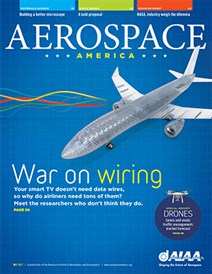One of the latest trends is to reduce wired communication and transfers by updating systems to wireless capabilities. Industries embracing this shift include energy, technology, subsea communication and aviation.
 Recently, Aerospace America dove into exactly what it would take to significantly reduce the amount of wire on an aircraft. This has the potential to eliminate a significant portion of the almost 7,400 kilograms of wire found on some modern aircraft.
Recently, Aerospace America dove into exactly what it would take to significantly reduce the amount of wire on an aircraft. This has the potential to eliminate a significant portion of the almost 7,400 kilograms of wire found on some modern aircraft.
“Many of these wires supply electricity to components, but many others transmit operational data, including avionics, flight-control commands and sensor data on the performance of components like pneumatic and hydraulic systems,” wrote Henry Canaday, a contributor for the magazine. “Research engineers think that in five years they will have cleared enough technical and regulatory hurdles to begin replacing many data-carrying wires with wireless transceivers.”
Dr. David Redman and a team of researchers from the Aerospace Vehicle Systems Institute (AVSI) in the Department of Aerospace Engineering at Texas A&M University have worked over the last 10 years to make this technology possible.
“The Wireless Avionics Intra-Communications (WAIC) project, conducted through AVSI, is a collaboration of major aerospace companies working together to address common issues associated with wireless avionics,” Redman said.
Sensors are increasing on modern aircraft in order to improve efficiency, reliability and safety of flight. This in turn creates a vast amount of data describing the state of the aircraft that must be collected, processed and utilized by aircraft functions. Traditionally, this has required additional wires to distribute the data on board the aircraft.
“These traditional onboard data communications systems require complex electrical wiring and harness fabrication which adds weight to the aircraft, and in turn, increases fuel burn,” Redman said. “These systems are also unreliable and difficult to reconfigure, and rely on double or even triple redundancy to mitigate the risk of cut or defective wiring.”
WAIC solely addresses the required radio communication between components integrated or installed on board the same aircraft. This communication is transmitted through an exclusive network between two or more points on a single aircraft and does not provide air-to-ground, air-to-satellite or air-to-air communications.
 “There are multiple factors motivating the aviation industry to adopt technology such as WAIC,” Redman said. “These include weight savings gained by reducing wiring, harnesses and connectors, and leading to improved fuel efficiency of the aircraft, enabling the reliable monitoring of aircraft functions that cannot be practically monitored with wired sensors, and improved reliability of aircraft systems through mitigation of common mode failures by means of dissimilar redundancy.”
“There are multiple factors motivating the aviation industry to adopt technology such as WAIC,” Redman said. “These include weight savings gained by reducing wiring, harnesses and connectors, and leading to improved fuel efficiency of the aircraft, enabling the reliable monitoring of aircraft functions that cannot be practically monitored with wired sensors, and improved reliability of aircraft systems through mitigation of common mode failures by means of dissimilar redundancy.”
Previous AVSI WAIC projects worked though the International Telecommunications Union (ITU-R) to gain a worldwide allocation for use of the 4.2 – 4.4 GHz frequency band for use by WAIC. This frequency band had been used exclusively by radar altimeters, which measure the distance from the bottom of the plane to the ground below by timing how long it takes to reflect a radio wave from the ground and return to the plane. Today, Redman and his team are performing laboratory characterization of the effects of WAIC on radar altimeters to support the design and specification of future WAIC systems.
“The Texas A&M team has established a reference test apparatus that measures the effect of candidate WAIC radio signals on the accuracy of radar altimeters,” Redman said. “These altimeters are necessary for the safe operation of aircraft, so WAIC is being designed to avoid interfering with their operation. We have tested multiple altimeter models from the major commercial altimeter manufacturers and are preparing to validate these tests with flight testing in late 2017.”
According to their website, Aerospace America reaches approximately 25,000 aerospace professionals and hundreds of engineering and aerospace libraries. It is a publication of the American Institute of Aeronautics and Astronautics that presents the latest information and analysis of industry issues and technologies in an inviting and engaging format.